Nestled in the verdant Sahyadri mountains near Lonavala, the Korigad Trek offers a perfect blend of history, adventure, and natural beauty. Rising 929 meters above sea level, this ancient fort trek has captivated adventurers with its well-preserved structures, panoramic views, and relatively accessible trails. Whether you’re a weekend warrior from Mumbai seeking a quick escape or a dedicated trekker looking to explore Maharashtra’s rich fort heritage, this comprehensive guide will prepare you for an unforgettable journey to Korigad Fort.
The historic Korigad Fort stands majestically amidst the Sahyadri range near Lonavala
Korigad Trek Overview: Location and Historical Significance
Korigad Fort (also called Koraigad, Koarigad or Kumwarigad) is located approximately 20 km south of Lonavala in Pune district, Maharashtra. Standing at an elevation of 929 meters (3,049 feet), the fort rises about 200 meters higher than the surrounding valleys, offering breathtaking views of the Sahyadri mountains and nearby attractions like Pawna Lake and Aamby Valley.
Key Details
- Trek Difficulty: Easy to Moderate
- Base Village: Peth Shahpur
- Elevation: 929 meters (3,049 feet)
- Trek Duration: 1-1.5 hours one way
- Total Distance: Approximately 4 km round trip
- Nearest Railway Station: Lonavala (20 km)
- Distance from Mumbai: 107 km
- Distance from Pune: 91 km
Historical Significance
Korigad Fort’s construction date is not precisely known but likely predates 1500. The fort gained strategic importance during the Maratha era. In 1657, Chhatrapati Shivaji Maharaj captured Korigad along with other forts like Tung, Tikona, Visapur, and Lohagad. After the Treaty of Purandar, Shivaji retained Korigad, highlighting its strategic value.
The fort eventually fell to British forces on March 14, 1818, after a three-day battle. British troops managed to destroy the ammunition storage with cannon fire, forcing the Maratha defenders to surrender despite their valiant resistance.
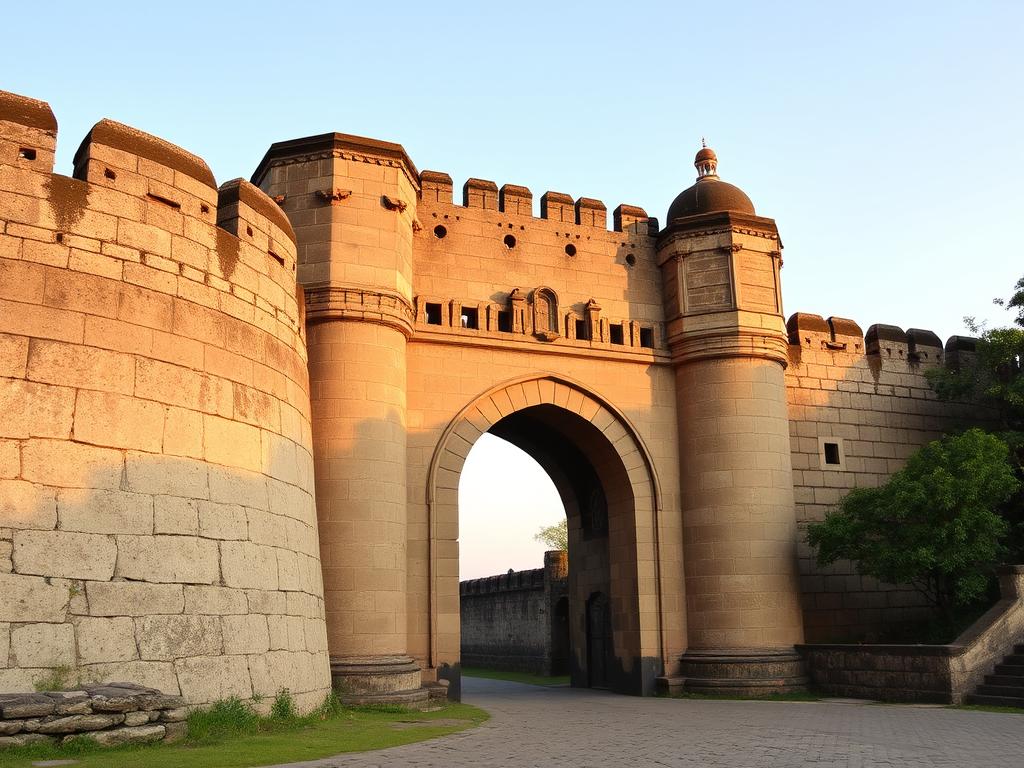
The historic entrance gate of Korigad Fort showcases classic Maratha military architecture
Best Time to Visit Korigad Trek
The Korigad Fort trek can be enjoyed year-round, but each season offers a distinct experience. Understanding the seasonal variations will help you plan your trek for optimal enjoyment and safety.
Monsoon Season (June-September)

Pros
- Lush green landscapes
- Spectacular waterfalls
- Dramatic cloud formations
- Moderate temperatures
Cons
- Slippery trails
- Limited visibility on cloudy days
- Potential for heavy rainfall
- Leeches in some areas
Winter Season (October-February)
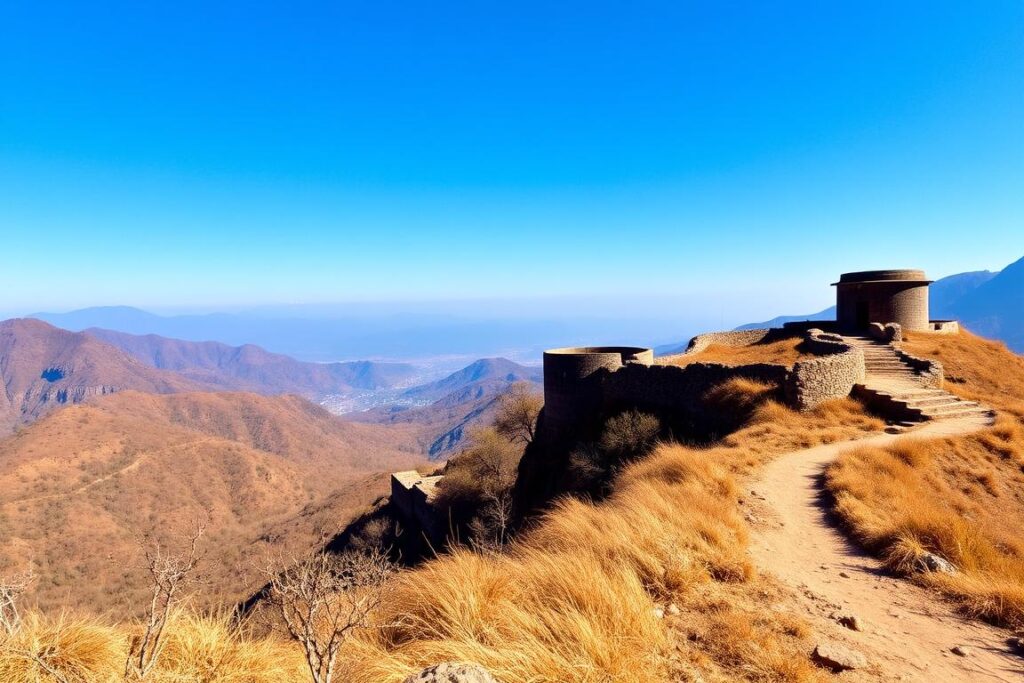
Pros
- Clear visibility
- Comfortable temperatures
- Dry trails
- Perfect for photography
Cons
- Less greenery
- Chilly mornings and evenings
- Water sources may be limited
- More crowded on weekends
Summer Season (March-May)

Pros
- Excellent visibility
- Night treks possible
- Less crowded
- Stargazing opportunities
Cons
- Hot daytime temperatures
- Limited shade on the trail
- Higher water requirements
- Dry landscapes
Recommended Time: The ideal time for Korigad Trek is during the post-monsoon season (September to November) when the landscapes remain green, temperatures are moderate, and trails are less slippery. Winter (December to February) is also excellent for clear views and comfortable trekking conditions.
Korigad Trek Difficulty and Fitness Requirements
The Korigad Trek is generally rated as easy to moderate, making it suitable for beginners and families with reasonable fitness levels. The trek involves climbing approximately 600 steps to reach the summit, with a moderate incline throughout most of the trail.
Terrain Details
The trail begins from Peth Shahpur village with a gradual ascent through forested areas. As you progress, you’ll encounter stone-cut steps dating back centuries. The path is well-defined and doesn’t require technical climbing skills. The final approach to the fort entrance features steeper steps but remains manageable for most trekkers.
Duration and Pace
Most trekkers complete the ascent in 1 to 1.5 hours at a moderate pace. The descent typically takes 45 minutes to 1 hour. Plan for a total of 4-5 hours for the complete experience, including exploration of the fort premises and rest breaks.
Fitness Requirements
- Ability to walk continuously for 1-2 hours
- Comfort with climbing stairs
- Basic cardiovascular fitness
- BMI preferably under 30 for comfortable trekking
- No specific technical skills required
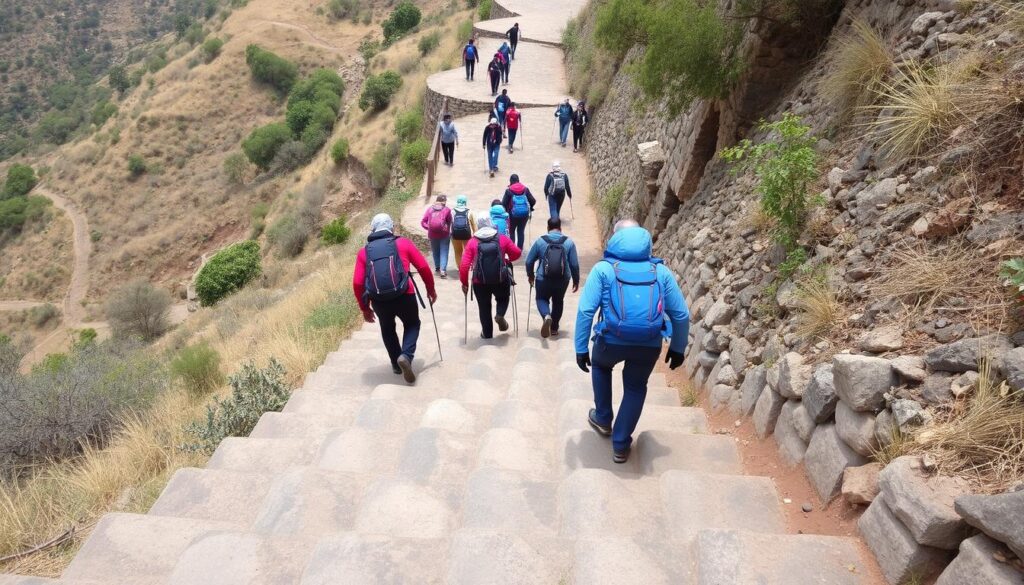
Trekkers of various fitness levels can comfortably navigate the stone steps leading to Korigad Fort
Preparation Checklist for Korigad Trek
Essential Items to Pack
- Water: 2-3 liters per person (more in summer)
- Food: Energy bars, dry fruits, sandwiches, light meals
- Backpack: 20-30 liter daypack with rain cover
- First Aid Kit: Band-aids, antiseptic, personal medications
- Navigation: Map, compass, or offline GPS app
- Documentation: ID proof, emergency contacts
- Power Bank: For emergency phone charging
- Cash: Small denominations for local purchases
- Garbage Bag: To carry back all waste
Clothing and Footwear
- Footwear: Trekking shoes with good grip (essential)
- Clothing: Quick-dry, breathable fabrics
- Full-sleeve shirts: Protection from sun and insects
- Trekking pants: Comfortable with multiple pockets
- Cap/Hat: Protection from sun
- Sunglasses: UV protection
- Rainwear: Poncho or waterproof jacket (monsoon)
- Extra pair of clothes: For changing after the trek
- Light jacket: For winter treks (Oct-Feb)
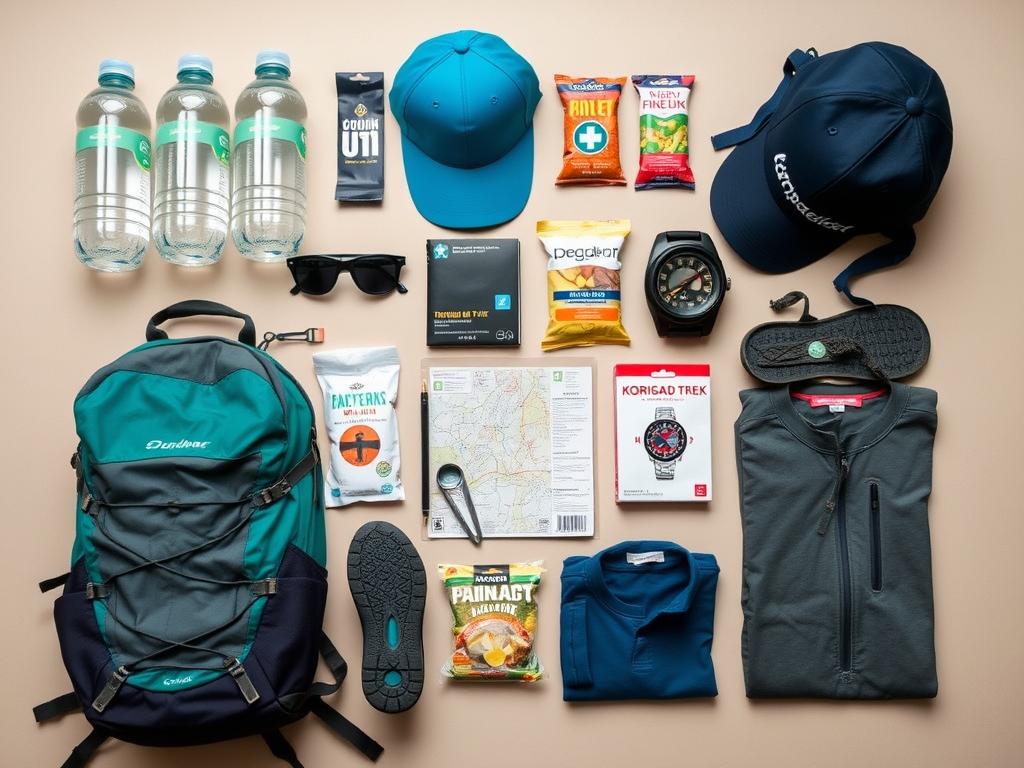
Essential gear for a successful Korigad Trek experience
Hydration and Food Tips
Hydration Strategy
- Start hydrating the day before your trek
- Carry at least 2 liters of water per person
- Add electrolytes or ORS to one water bottle
- Take small sips frequently rather than large amounts occasionally
- Avoid alcohol the night before (causes dehydration)
- There are no reliable water sources on the fort, so carry sufficient water
Food Recommendations
- Eat a carbohydrate-rich breakfast before starting
- Pack lightweight, high-energy foods
- Bring mix of sweet and savory snacks
- Carry fruits like bananas and apples
- Include protein sources like nuts or protein bars
- Local food may be available at base village but not on the fort
Join Our Trek Community
Connect with fellow trekkers, get exclusive preparation tips, and receive updates about upcoming Korigad Trek events.
Korigad Trek Route Details
Starting Points
The primary base village for Korigad Trek is Peth Shahpur, which can be reached from three major cities:
From Mumbai (107 km)
- Take the Mumbai-Pune Expressway toward Lonavala
- Exit at Lonavala and follow signs to Aamby Valley
- Continue past Aamby Valley toward Peth Shahpur village
- Approximate travel time: 2.5-3 hours
From Pune (91 km)
- Take the Pune-Mumbai Highway toward Lonavala
- Exit at Lonavala and follow the route to Aamby Valley
- Continue to Peth Shahpur village
- Approximate travel time: 2-2.5 hours
From Lonavala (20 km)
- Take the road toward Aamby Valley
- Continue past Aamby Valley toward Peth Shahpur
- Approximate travel time: 45 minutes
Public Transportation Options
By Train: The nearest railway station is Lonavala, well-connected to both Mumbai and Pune. From Lonavala station, you can hire a taxi to Peth Shahpur (approximately 45 minutes).
By Bus: Regular buses operate from Mumbai and Pune to Lonavala. From Lonavala bus stand, you’ll need to hire a local taxi to reach Peth Shahpur.
Trail Description
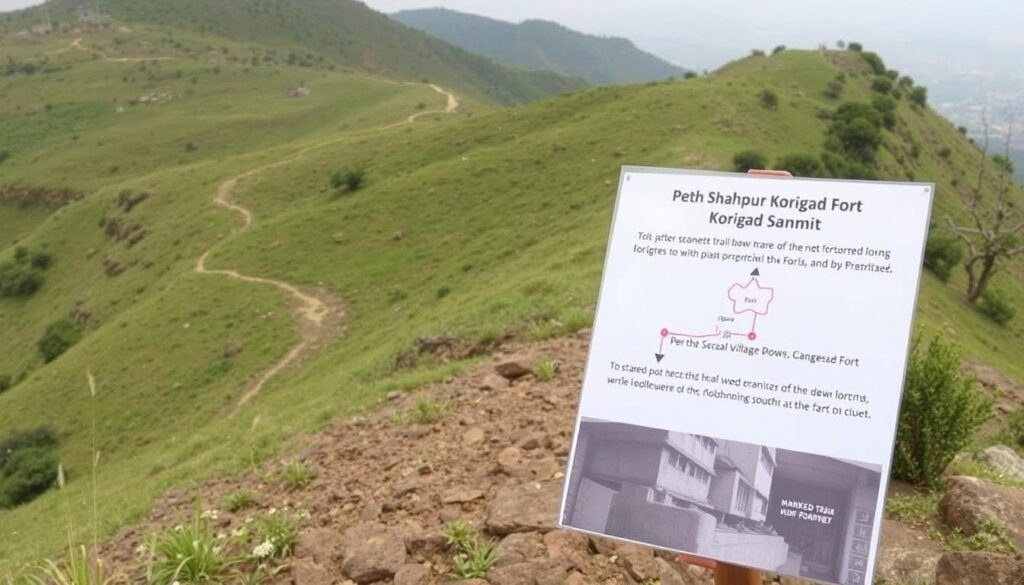
The well-marked trail from Peth Shahpur village to Korigad Fort summit
Trail Markers and Landmarks
- Village Start Point: Begin at Peth Shahpur village temple
- Initial Path: Follow the dirt road heading toward the hill
- Forest Section: Enter a forested area with a gradually increasing incline
- First Plateau: Reach a small clearing with views of surrounding hills
- Stone Steps Begin: Ancient stone steps start approximately 20 minutes into the trek
- Midway Rest Point: A flat area with a small shrine, ideal for a short break
- Final Ascent: Steeper steps leading directly to the fort entrance
- Fort Entrance: Large stone gateway marking the entrance to Korigad Fort
Important Route Notes
- The trail is well-trodden and easy to follow
- Yellow arrows painted on rocks mark the correct path at junctions
- Total distance from base to summit is approximately 2 km one way
- Average ascent time is 1-1.5 hours at a moderate pace
- The trail offers occasional shade but has exposed sections
- Mobile network is available intermittently throughout the trek
- Local guides are available at the base village (₹300-500)
Download Korigad Trek Map
Get our detailed trail map with marked routes, rest points, and key attractions on Korigad Fort.
Attractions on Korigad Fort
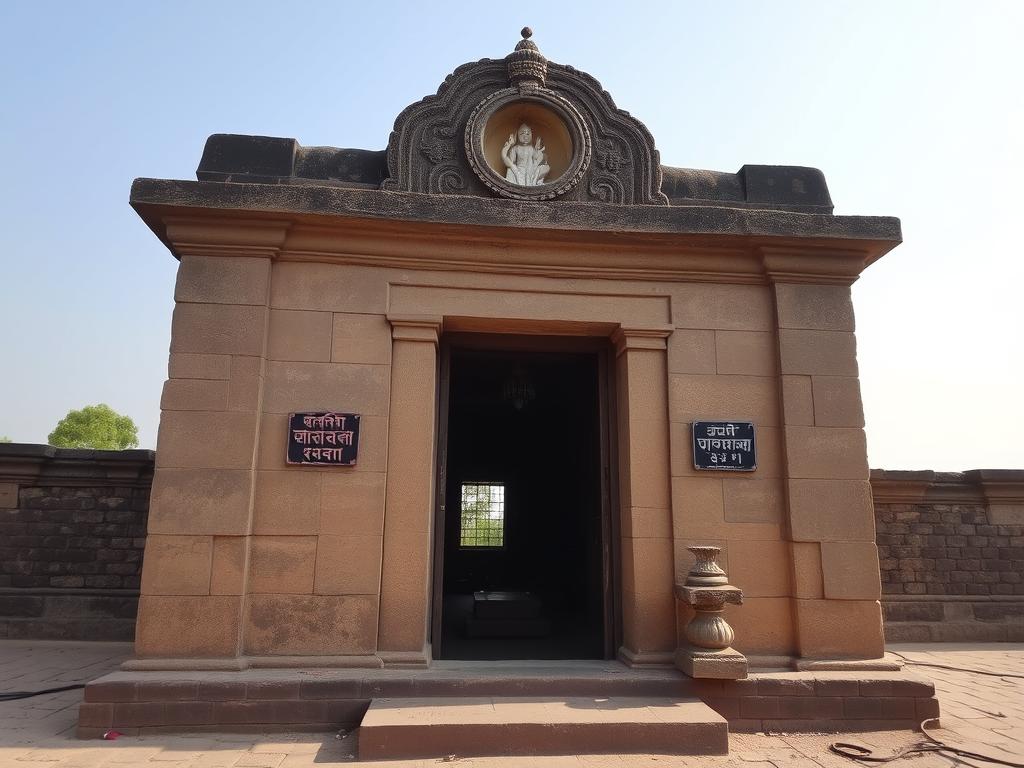
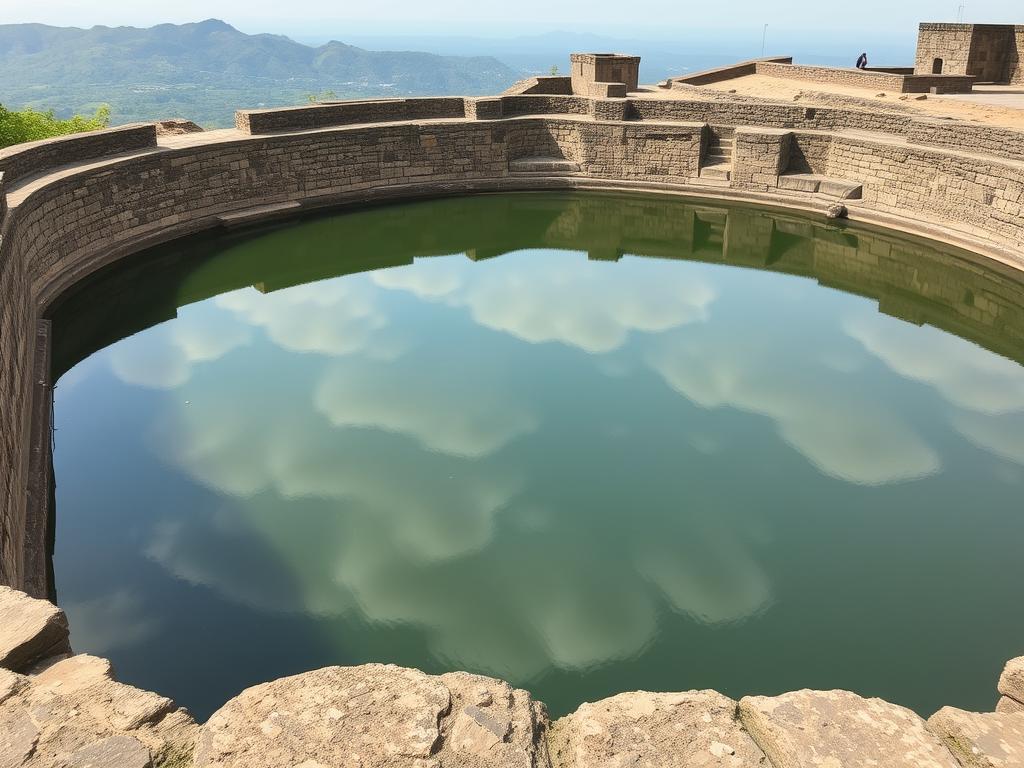
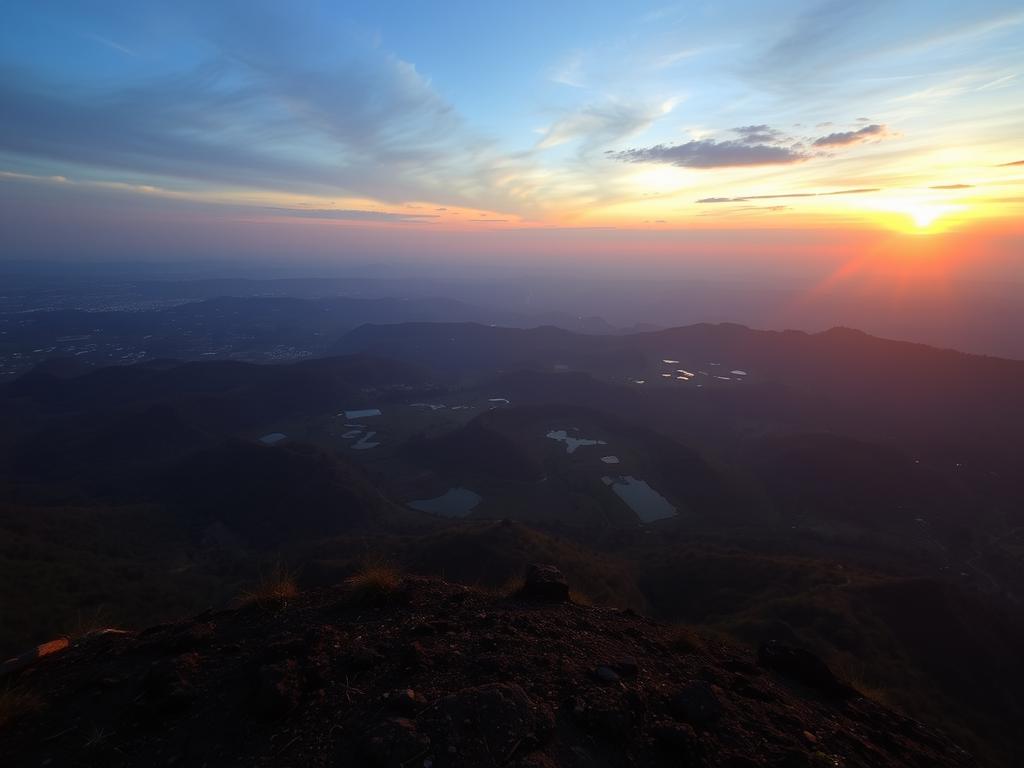
Fort Structures
- Fort Walls: Well-preserved 3-4 meter high stone walls encircling the fort
- Entrance Gate: Imposing stone gateway with historical significance
- Bastions: Six strategic bastions offering panoramic views
- Ammunition Depot: Ruins of the storage area destroyed during the 1818 battle
- Water Cisterns: Ancient water storage systems
Religious Sites
- Korai Devi Temple: Main temple dedicated to the fort’s deity
- Mahadev Temple: Ancient shrine to Lord Shiva
- Small Shrines: Various smaller religious structures throughout the fort
- Stone Carvings: Historical inscriptions and religious symbols
- Prayer Flags: Colorful flags often adorning the temples
Natural Attractions
- Twin Lakes: Two water bodies on the fort plateau
- Sunset Point: Western bastion offering spectacular sunset views
- Valley View: Eastern side overlooking Aamby Valley
- Bird Watching: Various bird species in the fort area
- Camping Spots: Flat areas suitable for overnight camping
Photography Spots on Korigad Trek
Best Daytime Photography Locations
- Eastern Bastion: Capture views of Aamby Valley and artificial lakes
- Northern Wall: Frame the fort walls against the mountain backdrop
- Temple Complex: Document the historical architecture and religious practices
- Fort Lakes: Photograph reflections in the still water bodies
- Stone Steps: Capture the ancient pathway during the ascent
Sunset and Golden Hour Spots
- Western Bastion: Prime location for sunset photography
- Southern Viewpoint: Capture golden light on the Sahyadri ranges
- Main Gate: Photograph the entrance illuminated by evening light
- Central Plateau: Wide-angle shots of the entire fort complex
- Descent Path: Capture the trail with valley views during golden hour

The western bastion of Korigad Fort offers spectacular sunset photography opportunities
Safety Tips for Korigad Trek
Important Safety Notice
While Korigad Trek is considered relatively safe and suitable for beginners, all outdoor activities carry inherent risks. Follow these guidelines to ensure a safe trekking experience.
Weather Precautions
- Check weather forecasts before starting your trek
- Avoid trekking during heavy rainfall or thunderstorms
- Start early to avoid afternoon heat in summer
- Carry appropriate rain protection during monsoon
- Be prepared for sudden weather changes
- Descend immediately if you notice dark clouds forming
Trail Safety
- Stay on marked trails at all times
- Trek in groups of at least 3-4 people
- Inform someone about your trek plan and expected return
- Wear appropriate footwear with good grip
- Use trekking poles for better stability if needed
- Move carefully on wet or loose surfaces
Health Considerations
- Carry sufficient water to prevent dehydration
- Apply sunscreen and wear a hat for sun protection
- Bring personal medications and a basic first aid kit
- Take regular breaks during the ascent
- Listen to your body and don’t overexert
- Inform your trek leader about any medical conditions
Wildlife Precautions
The Korigad area has some wildlife, though encounters are rare. Follow these guidelines for safety:
- Make noise while trekking to alert animals of your presence
- Do not feed or approach any wild animals you might encounter
- Check for insects or snakes before sitting on rocks or logs
- Carry insect repellent, especially during monsoon season
- Keep food sealed to avoid attracting animals
- Do not trek after dark when wildlife is more active
Emergency Contacts
- Local Police Station (Lonavala): 02114-273300
- Emergency Medical Services: 108
- Forest Department: 02114-273125
- Tourist Helpline: 1800-229930
- Disaster Management: 022-22694725
Nearest Medical Facilities
- Lonavala Rural Hospital: 20 km from Peth Shahpur
- Parmar Hospital: Lonavala, 22 km from trek base
- Aamby Valley Medical Center: 10 km from Peth Shahpur
- Pune Hospitals: 90 km from trek location
Frequently Asked Questions About Korigad Trek
Is Korigad Trek safe for beginners?
Yes, Korigad Trek is considered one of the safest and most beginner-friendly fort treks near Mumbai and Pune. The well-defined trail, moderate incline, and relatively short duration (1-1.5 hours one way) make it suitable for first-time trekkers with basic fitness levels. However, beginners should still trek with experienced companions or guides, especially during monsoon when trails can be slippery.
Can I do Korigad Trek in one day from Mumbai?
Yes, Korigad Trek can be completed as a day trip from Mumbai. The journey from Mumbai to Peth Shahpur takes approximately 2.5-3 hours, and the trek itself requires about 4-5 hours including exploration time. Start early (around 6 AM) from Mumbai to have sufficient time for the trek and return journey. Alternatively, organized trek groups often arrange transportation with early morning pickup from various Mumbai locations.
Are there toilets or food facilities available on Korigad Fort?
There are no permanent toilet facilities or food stalls on Korigad Fort. Basic toilet facilities may be available at the base village of Peth Shahpur. It’s advisable to carry sufficient food and water for the entire trek. Some local villagers occasionally sell tea, water, or basic snacks at the base village, but availability is not guaranteed. Practice responsible trekking by carrying back all your waste.
Is camping allowed on Korigad Fort?
Yes, camping is possible on Korigad Fort as there are several flat areas suitable for pitching tents. The Korai Devi temple area can accommodate approximately 25 people for overnight stays. However, there are no formal camping facilities, so you must carry all necessary camping equipment. Inform local authorities or village representatives about your camping plans. During monsoon, check weather forecasts carefully before planning an overnight stay.
What is the mobile network connectivity like on Korigad Trek?
Mobile connectivity is limited but available intermittently throughout the Korigad Trek. Most major Indian cellular networks (Jio, Airtel, Vodafone-Idea) work at the base village and at various points on the fort, though signal strength may vary. The fort top generally has better connectivity than the trail. It’s advisable to download offline maps before starting the trek and inform someone about your trekking plans as a safety precaution.
Conclusion: Your Korigad Trek Adventure Awaits
The Korigad Trek offers a perfect blend of accessibility and adventure, making it an ideal choice for both beginners and experienced trekkers. With its rich historical significance, well-preserved structures, and breathtaking views, this fort trek delivers an unforgettable experience in the heart of the Sahyadri mountains.
Whether you’re planning a quick weekend escape from Mumbai or Pune, or seeking to explore Maharashtra’s magnificent fort heritage, Korigad promises to reward your efforts with its natural beauty and cultural significance. The relatively easy trail, combined with the fort’s impressive features, makes this trek a must-do for anyone looking to experience the magic of the Western Ghats.
Remember to trek responsibly, respect the historical structures, and leave no trace behind. With proper preparation and respect for safety guidelines, your journey to Korigad Fort will surely become a cherished memory.

The sense of achievement upon reaching Korigad Fort makes every step of the journey worthwhile
Ready for Your Korigad Trek Adventure?
Book your guided trek experience with experienced leaders, transportation from Mumbai/Pune, and all necessary arrangements.
Share your Korigad Trek experience in the comments below!

